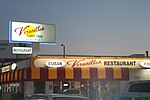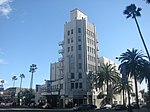Temple Beth Am (Los Angeles, California)
1935 establishments in California1959 establishments in CaliforniaConservative synagogues in CaliforniaJewish organizations established in 1935Synagogues completed in 1959 ... and 1 more
Synagogues in Los Angeles

Temple Beth Am (formerly: Olympic Jewish Center) is a historic Conservative synagogue in Los Angeles, California. Founded in 1935, it moved into a new building designed by one of the earliest African-American architects in Los Angeles, Ralph A. Vaughn, in 1959. In recent years, it has received significant donations from Holocaust survivor Sigi Ziering and his wife, Marilyn, whose names are on the building.
Excerpt from the Wikipedia article Temple Beth Am (Los Angeles, California) (License: CC BY-SA 3.0, Authors, Images).Temple Beth Am (Los Angeles, California)
La Cienega Boulevard, Los Angeles
Geographical coordinates (GPS) Address External links Nearby Places Show on map
Geographical coordinates (GPS)
| Latitude | Longitude |
|---|---|
| N 34.05823 ° | E -118.37658 ° |
Address
Temple Beth Am
La Cienega Boulevard
90211 Los Angeles
California, United States
Open on Google Maps








